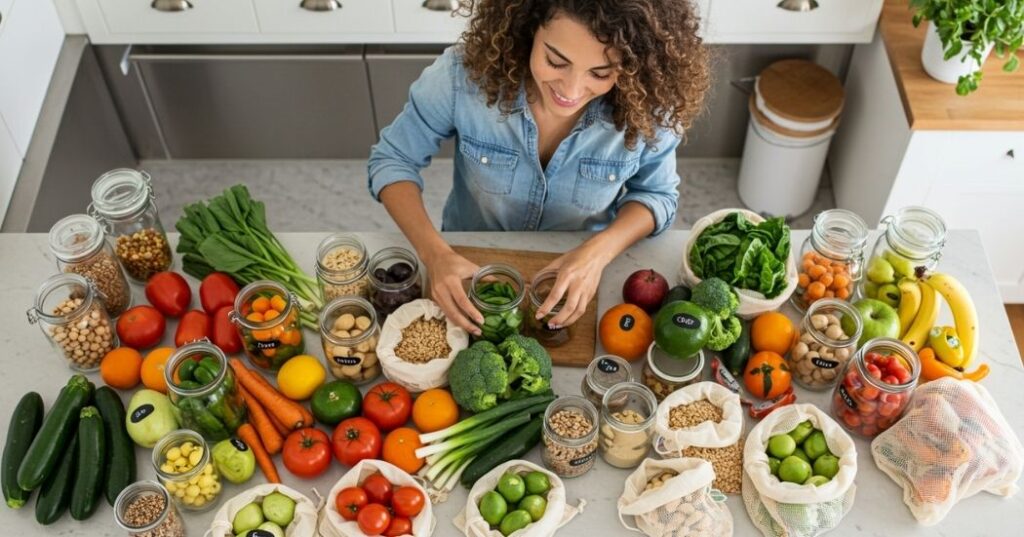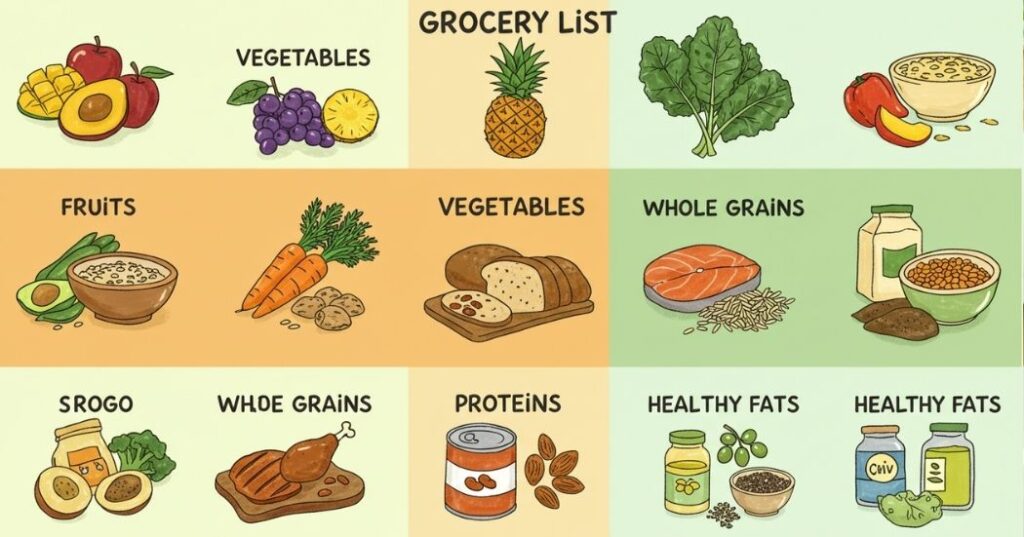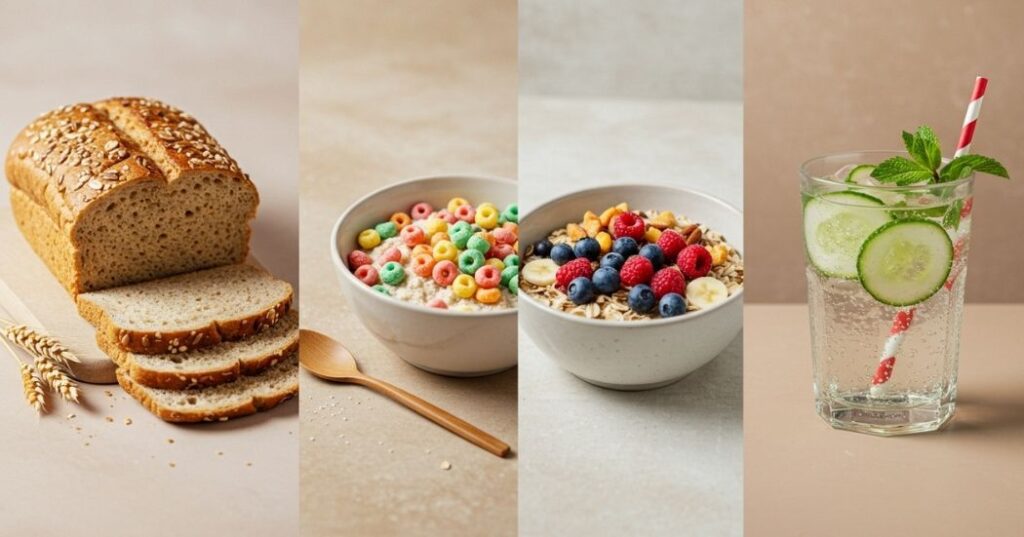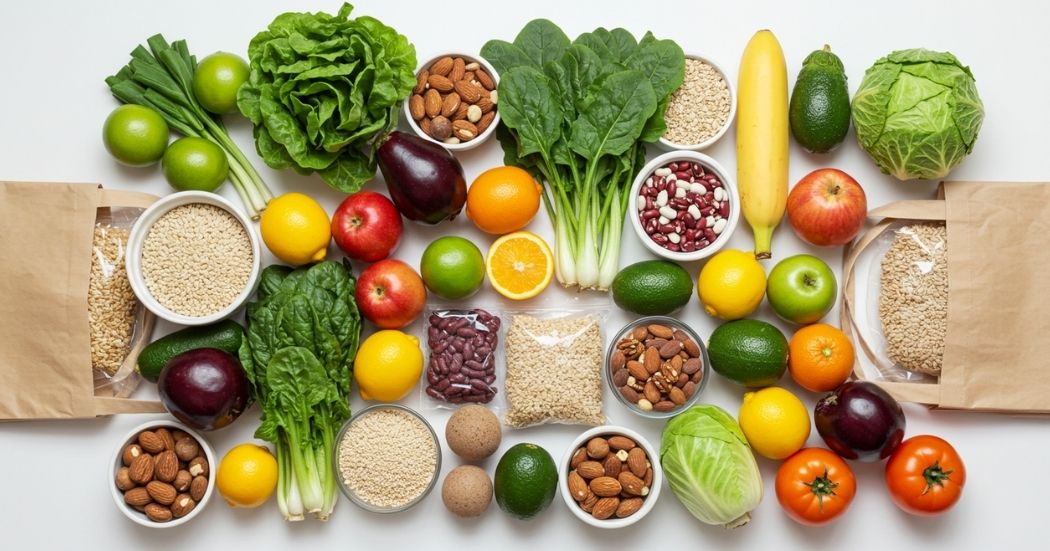Embarking on a clean eating journey begins with stocking your kitchen with the right ingredients. This comprehensive grocery list will guide you through the essentials needed to create nutritious and delicious meals.
The Philosophy of Clean Eating

Before we dive into the list, let’s solidify what “clean eating” truly entails. It’s not a diet in the restrictive sense, but rather a lifestyle approach focused on consuming whole, unprocessed foods as close to their natural state as possible. This means prioritizing ingredients that are nutrient-dense and free from artificial additives, excessive sugars, unhealthy fats, and refined grains. The goal is to nourish your body, improve energy levels, support digestive health, and potentially reduce the risk of chronic diseases. It’s about making mindful choices that serve your long-term well-being.
🥦 Fresh Produce: Nature’s Bounty
Fresh fruits and vegetables are the cornerstone of any clean eating plan. They provide essential vitamins, minerals, fiber, and antioxidants crucial for optimal health. When possible, opt for organic options, especially for items on the Environmental Working Group’s (EWG) “Dirty Dozen” list, which are known to have higher pesticide residues. Conversely, you can be less concerned about organic for items on the “Clean Fifteen.”

Fruits
Fruits are naturally sweet and packed with beneficial compounds.
- Apples: A versatile snack, rich in fiber and antioxidants. Choose a variety for different flavors.
- Bananas: Excellent for quick energy, potassium, and easy digestion. Great in smoothies or on their own.
- Berries (strawberries, blueberries, raspberries, blackberries): Antioxidant powerhouses! Perfect for breakfasts, snacks, or desserts. Frozen organic berries are a great year-round option if fresh aren’t available or are too expensive.
- Oranges & Grapefruits: Bursting with Vitamin C, essential for immune health.
- Avocados: A fantastic source of healthy monounsaturated fats, fiber, and various vitamins and minerals. Great for healthy dips, salads, or toast.
- Lemons and Limes: Indispensable for adding zest and acidity to dishes, dressings, and water.
Vegetables
Load up on a diverse array of vegetables to ensure a wide spectrum of nutrients.
- Leafy Greens (spinach, kale, arugula, romaine, Swiss chard): These are nutrient superstars, high in vitamins K, A, and C, and essential minerals. Use them in salads, smoothies, stir-fries, or as a base for meals.
- Broccoli & Cauliflower: Cruciferous vegetables known for their cancer-fighting properties and high fiber content. Roast them, steam them, or add them to stir-fries.
- Bell Peppers (red, yellow, orange, green): Rich in Vitamin C and antioxidants. Add crunch and color to salads, fajitas, or eat them raw with hummus.
- Carrots: Excellent source of beta-carotene, good for vision and skin health. Great raw or cooked.
- Cucumbers: Hydrating and refreshing, perfect for salads or infused water.
- Zucchini & Summer Squash: Versatile and mild-flavored, ideal for spiralizing into “noodles,” grilling, or sautéing.
- Sweet Potatoes: A complex carbohydrate packed with Vitamin A, fiber, and a natural sweetness. A healthier alternative to white potatoes.
- Onions & Garlic: Fundamental flavor bases for countless savory dishes, offering immune-boosting properties.
- Celery: Low in calories and hydrating, great for snacking or adding to soups and stews.
🍗 Proteins: Building Blocks for Health
Protein is essential for muscle repair, hormone production, and satiety. Focus on lean, minimally processed sources.
- Chicken Breast & Thighs: Versatile, lean protein. Opt for pasture-raised or organic when possible. Thighs offer more flavor and healthy fats.
- Turkey (ground, breast): A lean alternative to chicken, great for burgers, meatballs, or chili.
- Eggs: A complete protein source, incredibly versatile and affordable. Look for pasture-raised or organic eggs.
- Tofu & Tempeh: Plant-based protein powerhouses. Tofu is great for absorbing flavors, while tempeh offers a firmer, nuttier texture and is fermented, offering probiotic benefits.
- Legumes (lentils, chickpeas, black beans, kidney beans): Excellent plant-based protein and fiber sources. Buy dried in bulk or canned (rinse well to reduce sodium).
- Fish (salmon, cod, tilapia, sardines, tuna): Prioritize wild-caught fish for lower contaminant levels and higher omega-3 fatty acids. Salmon is particularly rich in beneficial fats. Choose tuna canned in water.
- Lean Red Meat (grass-fed beef, bison): In moderation, grass-fed options provide healthy fats and nutrients.
🌾 Whole Grains: Sustained Energy & Fiber
Whole grains retain all parts of the grain kernel (bran, germ, endosperm), meaning more fiber, vitamins, and minerals compared to refined grains.
- Brown Rice: A staple whole grain, perfect as a side dish or base for bowls.
- Quinoa: A complete protein and gluten-free “pseudo-grain,” rich in fiber and minerals.
- Oats (rolled or steel-cut): Ideal for breakfast, providing sustained energy and soluble fiber. Avoid instant oats with added sugars.
- Whole Wheat Bread/Sprouted Grain Bread: Look for loaves with minimal ingredients and no added sugars or high-fructose corn syrup. Sprouted grain breads are often easier to digest.
- Whole Grain Pasta: A healthier alternative to white pasta, offering more fiber.
- Barley: Chewy and nutritious, great in soups or as a side.
- Farro: An ancient grain with a nutty flavor and satisfying texture.
- Popcorn (kernels): A whole grain snack, just pop it yourself with a little healthy oil and sea salt.
🥜 Nuts and Seeds: Healthy Fats & Nutrient Boosters
These small but mighty foods are packed with healthy fats, protein, fiber, vitamins, and minerals. Opt for raw or dry-roasted, unsalted varieties.
- Almonds: Great for snacking, almond butter, or almond milk.
- Walnuts: Rich in omega-3s, good for brain health.
- Chia Seeds: Absorbent and high in fiber and omega-3s, excellent in smoothies, puddings, or as an egg substitute.
- Flaxseeds (ground): Another excellent source of omega-3s and fiber. Always buy ground for better absorption.
- Pumpkin Seeds (Pepitas): Good source of zinc and magnesium.
- Sunflower Seeds: Rich in Vitamin E and healthy fats.
- Nut Butters (peanut, almond, cashew): Choose natural versions with just nuts and maybe a little salt – no added sugars or hydrogenated oils.
🧂 Pantry Staples: Flavor & Foundation
These items are essential for cooking, adding flavor, and forming the base of many clean eating recipes.
- Extra Virgin Olive Oil (EVOO): A healthy fat for dressings, sautéing (at lower temperatures), and finishing dishes.
- Coconut Oil: Great for higher-heat cooking due to its stable nature.
- Apple Cider Vinegar (ACV): Useful for salad dressings, marinades, and its purported health benefits.
- Low-Sodium Soy Sauce or Tamari: A staple for Asian-inspired dishes. Tamari is a gluten-free alternative.
- Natural Nut Butters (peanut, almond, cashew): As mentioned above, stick to natural versions with minimal ingredients.
- Herbs and Spices (turmeric, cumin, oregano, basil, thyme, rosemary, chili powder, paprika, cinnamon, ginger): These are your flavor enhancers! They add depth and complexity without relying on salt, sugar, or unhealthy fats, and many have their own health benefits.
- Sea Salt & Black Pepper: Essential seasonings.
- Low-Sodium Broths (vegetable, chicken, beef): Great for soups, stews, and cooking grains. Check labels for added sugars or excessive sodium.
- Canned Tomatoes (diced, crushed, paste, whole): A versatile base for sauces, soups, and stews. Look for BPA-free cans if possible.
- Vinegars (balsamic, red wine): For dressings, marinades, and deglazing pans.
- Natural Sweeteners (maple syrup, raw honey, dates): Use sparingly and in moderation when a touch of sweetness is desired.
🥛 Dairy and Alternatives: Calcium & Creaminess
Choose unsweetened and organic options when available.
- Greek Yogurt (plain, unsweetened): High in protein and probiotics, excellent for breakfast or as a sour cream substitute.
- Almond Milk (unsweetened): A popular dairy-free alternative for smoothies, coffee, and cereals.
- Coconut Milk (canned, full-fat or light): Great for curries, soups, and adding creaminess to dishes. Choose unsweetened.
- Oat Milk (unsweetened): Another creamy, dairy-free option.
- Cheese (in moderation): If you consume dairy, opt for high-quality, minimally processed cheeses and enjoy them sparingly.
- Cottage Cheese: Another good source of protein.
💧 Beverages
- Water: The most important beverage. Drink plenty throughout the day.
- Herbal Teas: Hydrating and flavorful, often with added health benefits.
- Unsweetened Coffee/Tea: In moderation, without added sugars or excessive creamers.
🛒 Smart Shopping Strategies for Clean Eating

Having a list is great, but knowing how to navigate the grocery store is equally important for clean eating success.
1. Plan Your Meals in Advance
This is arguably the most crucial step. Before you even set foot in the store, think about your meals for the week. This helps you:
- Create a targeted shopping list: You’ll only buy what you need, reducing food waste and impulse purchases.
- Save money: No more random items ending up in your cart that you’ll never use.
- Ensure variety: Plan balanced meals incorporating different food groups.
- Reduce stress: Knowing what you’re making eliminates daily “what’s for dinner?” dilemmas. Consider theme nights (Meatless Monday, Taco Tuesday, Fish Friday) to simplify planning.
2. Make a Detailed Shopping List (and Stick to It!)
Once your meal plan is set, create a meticulous list.
- Organize by store section: Group produce, dairy, pantry items, etc., together to save time and prevent backtracking.
- Include quantities: How many apples? How many pounds of chicken? This avoids overbuying.
- Use an app: Many apps allow you to create and share lists, making it easy to check off items as you go.
3. Shop the Perimeter First
Most grocery stores are laid out with the freshest, least processed foods around the outer edges: produce, dairy, meat, and seafood. Fill your cart with these nutrient-dense items first. The inner aisles typically contain packaged, processed foods that you want to limit.
4. Read Food Labels Diligently
Don’t be swayed by marketing claims like “natural” or “healthy.” Flip the package over and scrutinize the ingredient list.
- Look for short ingredient lists: The fewer ingredients, the better.
- Recognize ingredients: If you can’t pronounce it or don’t know what it is, it’s likely a processed additive.
- Beware of hidden sugars: Sugar has many aliases (corn syrup, dextrose, maltose, sucrose, high-fructose corn syrup, etc.).
- Check sodium content: Opt for low-sodium versions of canned goods and broths.
- Avoid trans fats: Look for “partially hydrogenated oils” – these are trans fats.
- Understand serving sizes: Pay attention to nutritional information per serving.
5. Buy in Season and Support Local
Produce that’s in season is typically at its peak flavor, highest in nutrients, and often significantly cheaper.
- Check local farmer’s markets: A fantastic way to get fresh, often organic produce directly from growers, supporting your local economy.
- Consider a CSA (Community Supported Agriculture) box: You pay a farmer upfront for a share of their harvest throughout the season, receiving a box of seasonal produce weekly.
6. Don’t Shy Away from Frozen or Canned (Smartly)
Frozen and canned options can be just as nutritious as fresh, especially when fresh isn’t available or affordable.
- Frozen Fruits and Vegetables: Often picked at peak ripeness and flash-frozen, locking in nutrients. Look for plain versions without added sauces, sugars, or sodium. Great for smoothies and stir-fries.
- Canned Goods: Canned beans, lentils, and tomatoes are excellent pantry staples. Always rinse canned beans and lentils thoroughly to remove excess sodium. Look for “no salt added” or “low sodium” versions. Choose BPA-free cans if possible.
7. Buy in Bulk for Savings
For non-perishable items like grains (oats, quinoa), nuts, seeds, and dried beans/lentils, buying from the bulk bins can significantly save money and reduce packaging waste. Just make sure to store them properly in airtight containers.
8. Shop on a Full Stomach
This might sound trivial, but shopping when hungry can lead to impulsive, less healthy purchases. Have a healthy snack before you head to the store to keep your cravings in check.
9. Don’t Be Afraid to Adjust
Your clean eating journey is personal. If certain foods don’t agree with you, or you find alternatives you prefer, adjust your list. The goal is sustainable, healthy eating, not strict adherence to someone else’s rules.
🧭 Ready to Take the Next Step?
Clean eating is more than just shopping smart—it’s about supporting your body with choices that nourish your energy, skin, and mood. Want glowing skin? Hydration matters. → Discover how morning hydration transforms your glow.
Craving more calm and joy in your day? → Try these mood-boosting foods.
Want to create a deeper connection with your food? → Learn how mindful movement supports healthier habits.
✨ Every grocery list is a chance to rewrite your routine.
Download your clean eating grocery list today, stock your kitchen with intention, and take one simple step toward a healthier, more vibrant you.
📚 References
- Best Clean Eating. Printable Clean Eating Grocery List
- The Gracious Pantry. Clean Eating Grocery Shopping List For Beginners
- Beyond Type 1. Clean Eating Grocery List
Ready to revolutionize your kitchen and your health? What’s the first item you’ll add to your clean eating grocery list this week?

